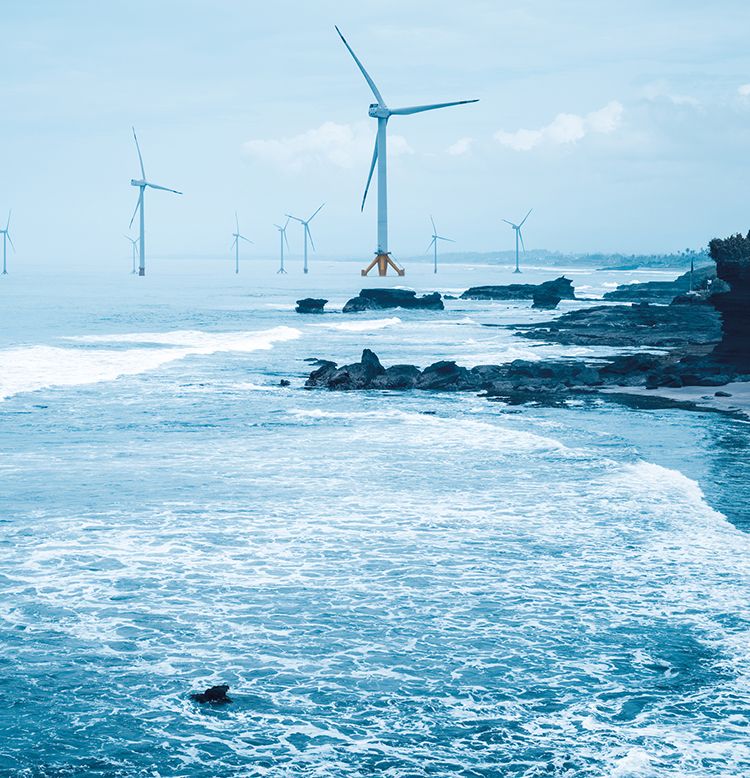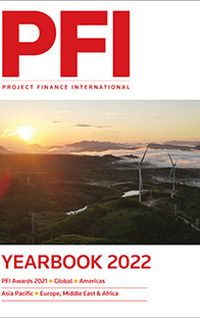Bank of the Year – SMBC
SMBC has emerged over the last few years as a global powerhouse in the project finance space, with a leading presence in all markets. It has moved some way ahead of its rivals this year with a loan market share of 5.6% across 125 deals thus far. On the bonds side it is well within the Top 10 and it has been involved in some important advisory mandates.
The bank has an impressive project finance team with more than 400 professionals across the globe. The banks biggest team is actually in New York, where it has more than 100 executives including its successful US private placement SMBC Nikko team headed by Edward Reznik. That team priced a US$1.5bn deal for Freeport LNG in the US and a US$1.435bn deal for GIP Capricorn in Australia, the largest ever individual offering in the country. Its US$229m deal for ConEdison Development’s solar portfolio saw the lowest spread for a renewables bond issue since 2018.
In its other major offices the bank has 90 in Tokyo, 80 in London, 40 in Singapore and 17 in Dubai. The breadth of its global coverage shows up in the range of countries in which it won advisory mandates this year – China, Taiwan, Bangladesh, Indonesia, Myanmar, Philippines, Sri Lanka, Vietnam, Peru, Chile, Mexico, the USA, Russia, Germany, Norway, the Netherlands, the UK, Denmark, Poland, Saudi Arabia, Omen, Kuwait, UAE, and last but not least Angola, where it is currently putting together a US$2.5bn financing for Eni and BP. It has 70 ongoing financial advisory mandates and successfully closed nine during the year.
Its two main standout advisories this year were the Dubai waste-to-energy (WtE) scheme, Warsan, and the US$15bn Aramco gas pipeline deal. The Warsan scheme is the world’s largest single WtE plant and required US$1.15bn in financing with more than US$900m in debt. SMBC arranged the deal with JBIC, Nexi and the commercial banks backed by a diverse sponsor group. This was the first time JBIC and Nexi financed a WtE deal. The Aramco deal, Project Saturn, is a monster financing backing the acquisition of a 49% stake in Aramco’s gas pipelines by a Blackrock-led team. Despite the size, the acquisition loan is very competitively priced.
SMBC is looking to become a global leader in the ESG space but within the needs of the energy transition and it remains an important energy bank. It is looking to have a net zero loan book by 2050. In the renewables space it has closed 43 deals totalling 19GW this year with ten as a green co-ordinator.
It was involved in the Chacao+ deal in Chile, the Cirata floating solar deal in Indonesia, and the Courseulles offshore wind project in France – all PFI award-winning deals. On the Courseulles deal it was able to join the lead underwriting and structuring group of three, knocking out some other French banks in the lead role in the process.
It picked up a new niche in the data centre sector by hiring data centre specialists to its team. It was one of the three lead banks on AXA IM’s Data4 deal in Europe – again a PFI Deal of the Year. Further data deals were done in Europe, Indonesia and Japan. On the infrastructure and PPP side it was involved in the award-winning Fargo Moorhead flood diversion scheme in the US and the awarding winning D4 road in the Czech Republic. It is a testament to the bank just how many award-winning deals it is involved with.
The global project finance team is run by Katsufumi Uchida from London, with JC Kreutz in charge in the US, Luca Tonello in Asia-Pacific and Yoshihiro Takami and Layth Irani in EMEA.
Bond House of the Year – Citi
Citi was the outstanding global bond house this year, racing clear atop the league tables and driving innovation in its deals. The New York-based heavyweight worked on over US$4.3bn in bond sales across 22 issuances for a 7.4% share in the projects market and has a spot atop the league tables by some margin. But the numbers are only part of the consideration.
Citi had a breadth of activity that was most impressive, closing green bond issues, emerging markets Rule 144A deals, and private placements, among other deal types. The group transacted in renewables, airports, ports, pipelines, and highways – it even led a deal to build schools in the United States through a public-private partnership (PPP). The bank had deals in all the major geographies, including North and South America, Europe, the Middle East, and Asia.
In terms of innovation, Citi was able to build out structures in the green bond market. The bank acted as joint bookrunner and joint green bond structuring agent for CMI Energia issuing US$700m in green notes, which optimised the company’s capital structure, consolidating all debt at the HoldCo level with a corporate-style transaction that refinanced OpCo project finance debt.
Citi was also joint bookrunner for Inversiones Latin America Power’s US$404m green bond issue refinancing the debt backing two operating wind projects in Chile, which on top of its green credentials showed Citi could provide the full suite of services for the deal, something which is becoming increasingly asked of project finance banks. Sponsors want one-stop shops, and Citi this year showed it could be just that and on this deal was also letter of credit issuing bank, indenture trustee, registrar, offshore collateral agent, paying agent, and transfer agent.
The bank is also at the forefront of the private placement market and in one of its deals helped Price George’s Country Education close a US$479m senior secured private placement to finance the design, build, operations, and maintenance of five new middle schools and one new K-8 school in Maryland through a PPP. The transaction represents the first PPP to finance the construction of US public schools priced in the Rule 4(a)(2) market, opening up possibilities for the future.
The bank worked on emerging markets Rule 144A projects, bringing EM infrastructure assets to one of the world’s largest pools of capital. The first was the massive US$1.1bn issue to finance Celeo Redes and APG’s acquisition of Colbun Transmision, comprising 42 transmission lines of 899km and 27 sub-stations in Chile. In another, Citi acted as global coordinator and joint bookrunner in the pricing of US$850m in bonds collateralised by SBM Offshore’s FPSO Illhabela in Brazil.
The bank was also nimble in its execution. As part of a liability management deal, Citi led Tocumen Airport’s tender offer and consent solicitation, which came alongside a new US$1.85bn dual-tranche issuance of senior secured notes. Structural enhancements included a US$100m pledged Covid Recovery Reserve that helped in landing the issuer a two-notch rating upgrade to BBB.
The bank was global coordinator for one of the year’s larger more successful deals, when it helped Galaxy Pipeline Assets BidCo tap a groundswell of interest from US accounts looking to grab exposure to a vital piece of Abu Dhabi's infrastructure as the springboard for a US$3.92bn dual-tranche offering. Initially. the company was seeking to raise about US$2.5bn but a book that doubled in size after the US open led to a reassessment of plans. In an update ahead of the US open the combined book stood at US$4.3bn. Within a few hours that had jumped to more than US$8.5bn for a minimum US$3bn deal.
The company also did muni deals and led the ambitious and innovative US$68.2m of AMT tax-exempt green bonds backing a facility in the burgeoning renewable natural gas (RNG) in Iowa that processes manure from three dairy farms through an anaerobic digestion process, opening up another market for project bond solutions. Citi served as bond underwriter, provided the letter of credit, and served as bond trustee on that deal.
Some other highlights include a power deal for Empresa Generadora de Electricidad Haina in the Dominican Republic, a bond for Red River Valley Alliance backing water and sewage projects in the US, and an issue for market stalwart Cheniere Energy Partners.
In sum, the breadth, innovation, flexibility, and ability to be at the forefront of market trends and major deals meant Citi was this year’s best project bond bank. The Citi team is led in the US in part by Nasser Malik, who was head of structured debt before becoming head of corporate banking, sustainability, and corporate transitions, Rick Campbell, director of project and infrastructure finance, and Miguel Picache, director and head of private placements. David Dubin is global head of infrastructure in London while Quyn Siew is head of Asia-Pacific infrastructure finance in Hong Kong.
Adviser of the Year – Santander
Santander has emerged as one of the leading global project finance banks over the last few years. Its target markets are Latin America, North America and Europe. It has built up its presence in lead-arranging bonds and, particularly advisory, where it uses its arranging and advisory skills in an almost seamless way.
It seeks competitive financing solutions and in the current liquid climate can encourage plenty of competition among banks. It offers clients an advisory service based on success. Its fee is marginal compared with the overall investment size and most fees are paid at financial close. It takes an arranging role in most of its advisory deals.
The standout financing this year was the Vineyard Wind, a longstanding advisory mandate for the first major US offshore wind deal. Iberdrola’s Avangrid and Copenhagen Infrastructure Partners raised US$2.5bn of project debt in this landmark deal. The debt equity/split was favourable to the banks at 56/44 and the tenor, in European terms, was short at 10 years. But the margin is competitive at 137.5bp and the deal received substantial backing – with nine original lead arrangers and a further 16 banks coming in during syndication.
In Europe, Santander advised on the long-term refinancing of the Enfinium waste assets in the UK. The bank was one of the original three banks that backed First Sentier Investors' successful bid for the SSE waste assets in the Multifuel joint venture with Wheelabrator/FSI, then won the bid for Wheelabrator itself. Santander and three others led the £1.65bn acquisition debt deal. Santander was then involved in two project financings for the sponsor and was mandated alongside FSI’s original financing adviser Jefferies to put a £1.9bn long-term debt package to take out the acquisition loan. The 10 and 26-year deal was strongly supported by banks and institutional investors and competitively priced.
In one of the largest infrastructure deals this year, Santander was the M&A and debt adviser on the New Suez transaction in France. A consortium of Global Infrastructure Partners (GIP), Meridiam, CDC and CNP bought out the part of Suez’s business not sold on to Veolia in a €10.4bn deal. Santander put in place a €2.25bn bridge loan, a €2.25bn short-term loan and a €750m revolving credit facility (RCF) with itself, Credit Agricole, Natixis and Societe Generale. The assets include Suez’s water assets in France and overseas.
The banks advised on the €543m Orange Polska deal in Poland, involving Orange selling 50% of it Polish subsidiary to APG and raising a Polish zloty non-recourse financing. Warsaw-headquartered Orange Polska set up a stapled financing with Santander, which led the lender group underwriting the facility which included BNP Paribas, ING, Societe Generale and EIB. Lenders joining later included KfW IPEX, mBank, Bank Pekao, PKO BP, BGK Bank and Raiffeisen Bank International joined through the syndication process.
Santander has always had a strong franchise in Latin America. This year the bank was involved in refinancing the US$800m SACE facility on the long-running Lima Metro 2 scheme. The Hitachi/ACS/FCC/WeBuild/Cosapi team won the deal back in 2015 backed by US$1.2bn of senior notes and the SACE facility. The notes were partially refinanced in 2019 and as construction delays continued the SACE facility was refinanced this year. Santander committed US$152m, 18.75%, of the loan to the deal which was closed days after a new far left president was elected. The deal was structured as a true sale to an offshore vehicle of the project’s revenue certificates. Another true sale deal for the bank was a US$200m financing in Chile backing generating companies losing out from a change in law. The deal was done under the IDB Invest A/B financing programme.
The bank advised on the local bond refinancing of the US$213m Puerta de Hierro 4G toll road in Colombia and four smaller deals in Brazil including a US$45m financing for Enel Green Power.
The structured finance team at Santander is headed by Benoit Felix in Madrid, a former head of the global infrastructure group.
Sponsor of the Year – Adani Green Energy
Adani Green Energy has ambitions to become the largest renewable energy generator in the world, and it is well on track to achieve this after a stellar year of innovative financings and portfolio growth.
Gautam Adani’s leading Indian conglomerate Adani Enterprises owns around 60% and French energy major TotalEnergies has a 20% stake acquired during 2021 for US$2.5bn. The Adani group set up Adani Green Energy in 2015 with the world’s largest single location solar power project, Kamuthi Solar with a 648MW capacity.
The developer came into 2021 with a bold aim to reach 25GW of renewable energy generation by 2025. However, at the COP26 Summit in November Adani Green raised the pace for the energy transition in setting a new target to get to 45GW by 2030. This would be 10% of the Indian government’s 450GW countrywide renewable energy aim for 2030.
So far, Adani Green has built up a portfolio of 20.3GW of projects, and should close 2021 with 8GW operational. Adani Green added 5GW of operational and development projects to its portfolio in a US$3.5bn acquisition this year, buying SB Energy India from SoftBank Group and Bharti.
The keep its astonishing pace of growth, Adani Green has raised large sums of project finance debt and refinanced assets with US dollar bond issuances. After a US$750m Adani Green Energy bond issue in September, the developer said it is fully funded to get to 25GW by 2025.
The developer devised an innovative and flexible debt structure earlier in the year to project-finance construction of a 1.69GW portfolio of three hybrid wind and solar projects in Rajasthan. The hybrid projects will be pathfinders for improving the issue of intermittency in renewables.
The US$1.35bn green loan is a four-year multi-tranche revolving facility for flexibility. Lenders have a bond distribution mandate built into the deal, as Adani intends to refinance the loan on the capital markets after construction of the assets. Lenders are Standard Chartered, MUFG, SMBC, DBS, Mizuho, BNP Paribas, Barclays, Rabobank, Deutsche Bank, Siemens, Intesa Sanpaolo and ING.
The loan is the largest renewables syndicated external commercial borrowing (ECB) project financing in India. In ESG markets, it sets a new record as the largest green certified hybrid project loan. It is the first and largest hybrid renewable portfolio project to achieve financial close in India, and one of the largest globally.
Adani Green won PPAs for a record breaking 8GW of solar generation in SECI’s first manufacturing-linked solar tender in 2020. Under that award, Adani Green signed the world’s largest ever renewables PPA for 4.67GW of energy in December 2021. As part of the 8GW solar offtake, Adani Green committed to the delivery of 1.5GW of new solar cells and modules manufacturing capacity in India. By the 2022/23 fiscal year, Adani Green plans to have a 2GW per year manufacturing capacity, contributing to the government’s push for more domestic solar equipment.
Adani, as one of India’s main industrial conglomerates, is globally significant in the energy transition and sets a high bar for its peers. India’s number one conglomerate Reliance Industries has this year responded by setting it own target of 100GW by 2030, a US$10bn investment plan over three years and plans for a 4GW solar equipment factory. India is a key market in the energy transition and its main public and private institutions are responding.
Investor of the Year – Meridiam
It has been quite the year for Meridiam, the Paris-based global developer and fund manager, with a substantial capital-raising supporting a series of landmark financings. The 2019 PFI Investor of the Year deservedly returns to the podium for its ambition, resilience, and results.
The company, headed since its 2005 inception by founder Thierry Deau, this year raised more than US$6bn in new capital across five funds, including two successor funds: Meridiam Sustainable Infrastructure Europe IV (MSIE IV), its fourth-generation European flagship fund, which reached its hard cap at €2.3bn this summer, five months after launch; and Meridiam Infrastructure Africa Fund II (MIAF II), its second Africa-focused fund, which had raised more than €500m by September and is expected to reach its €750m target.
The first of the new initiatives, The Urban Resilience Fund (TURF), is a global blended finance, impact fund launched in partnership with the Rockefeller Foundation and the United Nations Capital Development Fund (UNCDF) to deliver critical resilient infrastructure projects in cities. TURF, which has reached a first close of €290m, will invest in both Europe and Africa.
Second, The Green Impact Growth Fund (GIGF) is a growth equity fund providing capital to SMEs, “which are to become the champions of the ecological transition in Europe”. GIGF has already raised more than €150m, and will invest across the low carbon economy, circular economy, sustainable cities and smart buildings, clean mobility and sustainable agriculture and food sectors.
Third, Meridiam’s Sustainable Waste & Water Fund is being set up to acquire New Suez. Together with Global Infrastructure Partners (GIP), and Caisse des Depots (CDC) with CNP Assurances, it submitted a binding offer this summer for New Suez at an enterprise value of €10.4bn. New Suez is being created by larger peer Veolia’s takeover of French water management company Suez. It will focus on municipal water and solid waste in France, plus the water businesses in Italy, including the stake in Acea, the Czech Republic, Africa, including Lydec, Central Asia, India, China, Australia, and the global digital and environmental activities. The offer confirms the terms of the merger agreement signed on May 14 and includes a potential earn-out of €300m to be paid at the end of fiscal 2021.
On the project side, Meridiam began its string of 2021 achievements by reaching financial close on the €520m D4 motorway PPP in the Czech Republic. The all-commercial €475m 27.5-year debt features multi-currency tranches – local currency tranche, euro tranche, and equity bridge – and aggressive gearing of around 90%. This, on the first successful transport PPP in the country’s history.
Meridiam’s tenacity in Eastern Europe bore fruit at the end of spring. A host of legal challenges and political delays – global pandemic notwithstanding – were eventually overcome in Bulgaria to finance the Sofia Airport PPP with co-sponsors Munich Airport and Strabag.
In its home country, the company’s electric vehicle charging company Allego – acquired in 2019 – raised €55m in floating-rate volume-backed project finance debt to fund a rollout at Carrefour stores
In Africa, Meridiam is co-sponsor of the first large-scale biomass plant in Africa – Biovea, a 46MW scheme in Ivory Coast financed in June. French multilateral Proparco led the €165m financing for Biovea with a €135m concessional loan and €5m investment grant, EAIF provided a €30m loan and its parent PIDG is involved with a €8m grant. Capex was €228m, of which 72.3% is paid for by debt, 22% through sponsor equity and 5.7% with grants.
Meridiam also led development of the 34.1MW Kinguele Aval hydropower plant on the Mbei river in Gabon, the country’s first project-financed IPP. For Kinguele, IFC provided a €33m senior loan and up to €20m in the form of a concessional loan from its Canada-IFC Africa Renewable Energy Program, as well as mobilising €98m from the three other multilaterals. EAIF provided €25m while AfDB's involvement is split between €20m from its own account alongside €10m from the People's Bank of China-sponsored and AfDB-administered Africa Growing Together Fund (AGTF), while the Sustainable Energy Fund for Africa (SEFA), a special multi-donor fund managed by the bank, provided €9m of concessional financing.
The crown in the jewel – or the cherry on the sundae – might perhaps be the first-in-market West Guianan Power Plant (CEOG) hydrogen-based power plant in French Guiana, on which Meridiam is leading development with Hydrogene de France. A consortium of commercial and development banks provided the debt on the US$200m scheme.
The innovative project, which involves solar photovoltaic, lithium-ion storage, electrolysers and fuel cells, seeks to solve the issue of intermittency in renewables and the combination of short-term battery storage and longer-term hydrogen storage has essentially created baseload renewables. While still somewhat expensive – and understandably so – it appears the sponsors have cracked an important code in the energy transition campaign.
With the opening of two new African offices, Meridiam now has a presence in Senegal, Gabon, South Africa and Ethiopia on the continent, on top of its offices in France, Luxembourg, the US, Canada and Turkey. In conversation with PFI (see Yearbook profile), CEO Thierry Deau said to expect a “continued and increased focus on the energy transition” in 2022, from where many of Meridiam’s opportunities will come. With several more mega projects in the financing phase already, the investor is set to continue its impressive form.
Law Firm of the Year – Latham & Watkins
Latham & Watkins is the top law firm for 2021 project development and finance based on a series of complex transactions that demonstrated skill in both cross-border advising and innovative structuring.
The firm closed several financings that included a component that was a first of its kind, and its work spanned the sectors, from the development of rooftop solar electric generation to the development and financing of LNG facilities.
Over the past year the firm worked on more than 80 project financings with an aggregate value of approximately US$77bn. In one landmark deal that was several years in the making Latham advised lenders on Vineyard Wind, the first major offshore wind farm to achieve financial close in the US. After getting around multiple regulatory obstacles, the project was able to make it to financial close with banks providing senior credit facilities of up to US$2.3bn. A group of 25 banks ultimately took part in the syndication of the 800MW project off the coast of Massachusetts, which represents one of the largest investments in a single renewable energy project in the US.
In US conventional power, Latham served as primary legal counsel to ArcLight Capital Partners on a financing done through its Parkway Generation subsidiary. The transaction included a US$1bn senior secured Term Loan B and a US$140m senior secured Term Loan C backing its acquisition of a 6.7GW portfolio of eight natural gas-fired power generation facilities from New Jersey utility Public Service Enterprise Group (PSEG). The portfolio comprises 13 generation units in New Jersey, Connecticut, Maryland, and New York, including roughly 5.1GW of combined-cycle gas-fired projects, about 1.2GW of combustion turbine schemes, and a 450MW peaking plant.
In Latin America, Latham advised BTG Pactual and Santander as joint bookrunners, and Santander as social bond structuring agent, in the offering by Patrimonio Autónomo Montes de María of Ps760bn (US$209m) of its 4.1% senior secured notes due 2045. The notes refinanced a mini-perm facility backing the Montes de Maria 4G highway PPP toll road concession in the northern part of the country, which has become fully operational.
The bond issue was the first in Latin America to be guaranteed by the US International Development Finance Corporation (DFC) and was the first social bond offering for an infrastructure project in Latin America. Latham also advised multiple parties in the US$746m multi-source financing for the 4G toll road in Colombia. This deal consisted of a novel multi-source financing that was new to the Colombian 4G toll road market in combining bonds and local currency loans with US-dollar loans and interest rate and currency hedges into a single financing structure.
In Europe, the firm advised the European Bank for Reconstruction & Development (EBRD), the OPEC Fund for International Development, the African Development Bank (AfDB), and Arab Bank on a US$161m financing package involving financing from the Green Climate Fund (GCF) for the construction of ACWA Power's Kom Ombo 200MW solar power plant, the largest private solar plant in Egypt, in Aswan Province. The firm also advised First Sentier Investors (FSI) on its Enfinium waste M&A deal, including the £1.9bn refinancing of its acquisition debt.
Latham transacted a range of deals across the globe this year. Not only did it top the annual PFI Legal Survey for mandates totalling over US$500m, but more importantly it was the one firm that had the most even spread across the Americas, Asia-Pacific and Europe, the Middle East & Africa (EMEA), scoring particularly well in the Americas and EMEA. The firm is one of a number of leading American and English heritage firms that has a rich and ongoing history in the project finance arena.
Jeff Greenberg is the firm's Global Project Development & Finance Practice Chair and managing partner for the Los Angeles office. Late last year former Global Co-Chair of the Project Development & Finance Practice David Penna rejoined the firm in New York after serving as senior vice-president in the Office of Strategic Initiatives at the US International Development Finance Corporation (DFC).
ESG Deal of the Year – Vineyard Wind
Vineyard Wind – a joint venture between Avangrid Renewables and Copenhagen Infrastructure Partners (CIP) – has won the global environmental, social, and governance or ESG-focused project finance deal of the year, finally signalling that all systems are go for the build-out of offshore wind in the United States.
The sponsor closed US$2.448bn in total debt in September backing the project, which has ridden a wave of financial and regulatory support as the country looks to hit 30GW of installed offshore wind capacity by the end of the decade.
The size of the deal, its place as the first of its kind in the world’s most fertile project finance market, and the effort across the years by a whole host of parties around the world made this deal the standout globally in 2021. The financing was also one of the largest investments in a single renewable energy project in US history and the largest renewables project finance deal to close in 2021.
The deal was split across a main term loan with a nearly ten-year tenor, maturing on April 30 2031. Final sizing was US$2.344bn. There was a standby letter of credit signed for US$104m, maturing in just under three years on April 30 2024. Pricing on the deal is Libor plus 137.5bp. Commitment fees on the deal are 40bp. Total costs of the project are expected to be about US$4.1bn. The senior debt will cover 56% of the cost and the remaining 44% will be equity.
The transaction includes accordion arrangements for a potential tax equity bridge facility, as the project company is expected to claim the 30% investment tax credit on an eligible basis. The construction loan also converts to a back-leverage term loan with a seven-year tenor during the operation period.
A group of nine banks closed the deal, before syndicating it to the market. They were Santander, BNP Paribas, BBVA, Bank of America, MUFG, Credit Agricole, JP Morgan, Natixis, and NatWest. Santander also acted as financial adviser, hedge coordinator, and green loan coordinator, among other roles.
That original lender group was joined after syndication by Apple Bank, Associated Bank, Sabadell, Bank of China, Korea Development Bank (KDB), CaixaBank, KfW, BayernLB, CoBank, Commerzbank, Intesa Sanpaolo, Scotiabank, Norinchukin, Helaba, Shinsei Bank, and Standard Chartered, meaning a whopping 25 lenders took part in the financing.
Financing counsel for the sponsors was provided by Norton Rose Fulbright and White & Case. Latham & Watkins advised the lenders. CCA Group has been advising on tax equity.
“There have been many milestones passed over the last several months, from securing the final federal permits to signing the US’s first offshore wind project labour agreement,” said Vineyard Wind CEO Lars T. Pedersen when the deal closed. “Achieving financial close is the most important of all milestones because today we finally move from talking about offshore wind to delivering offshore wind at scale in the US.”
Vineyard Wind first acquired the Vineyard Wind lease area from a financial institution in 2016. In 2018, the Vineyard Wind 1 project entered into 20-year power purchase agreements (PPAs) with three local utilities in Massachusetts and all supply contracts were finalised by Q2 2021 with experienced international and local suppliers.
Vineyard Wind 1 will consist of an array of 62 wind turbines, spaced 1 nautical mile apart on an east-west and north-south orientation. The turbines are General Electric Haliade-X turbines, each capable of generating 13MW of electricity.
Vineyard recently held a groundbreaking ceremony for the offshore wind farm and the sea of dignitaries that attended indicates just how big this project is in the eyes of many. Secretary of the Interior Deb Haaland joined Massachusetts Governor Charlie Baker and others to commemorate the start of construction, which was made possible by this year’s most outstanding ESG-focused project financing.
Deal of the Year – Jazan
The Jazan Integrated Gasification & Power Company (JIGPC) financing was some deal by any measure. The US$12.1bn transaction involved Aramco selling its utilities infrastructure at the Jazan refinery to a joint venture made up of Air Products, itself, ACWA Power and Air Products/Vision Invest. At the same time the deal involved financing the gasifying of vacuum bottom oil to create syngas. This will fuel a 3,800MW power plant with 2,400MW of that sold to the national grid. In addition, JIGPC will produce hydrogen, steam and utilities that will be used in the refinery.
The sponsors raised US$7.3bn in debt to back the deal split, into a US$5.7bn commercial bank loan and a 14-year US$1.6bn loan from state soft loan institution SIDF. The deal sold well in syndication despite the ongoing effects of the Covid pandemic.
Twenty-two banks joined the US$5.7bn commercial loan – Saudi Fransi, Bank of China Dubai, Bank of China New York, Alinma, Riyad, Al Bilad, Apicorp, Bank Al Jazira, Standard Chartered, JP Morgan, Mizuho, Saudi British, Saudi National Bank, FAB, ADCB, Al Rajhi, SMBC, Samsung Life, and other South Korean institutional investors, Natixis, KDB, DZ, and Intesa Sanpaolo.
The commercial debt is split 50:50 between the seven-year hard mini-perm and a 17-year amortiser. The debt includes a seven and 17-year US dollar financing and seven-year Istisna-Ijara and Wakala-Ijara financing plus a 24-year fixed rate tranche provided by non-bank financial institutions. The deal will be backed by a two-year synthetic debt service undertaking (DSU).
Financial advisers on the deal were Standard Chartered and Fransi. Covington and Hatem Abbas Ghazzawi are legal advisers to the sponsors, White & Case to Aramco, and Shearman & Sterling and Dr Sultan Almasoud & Partners to the lenders. Related to the deal was a large ACWA Power financing, with the company selling US$728m of seven-year sukuk at 100bp over Saibor to fund its equity contribution. The spread was said to be the lowest in the Saudi capital markets by a corporate or bank issuer since 2017.
The Air Products/ACWA partnership is now moving on to financing the US$7bn hydrogen scheme as the new Neom city site in the kingdom. This will be the first large-scale green hydrogen scheme in the world and the financing should progress in 2022. Bob Carter will be busy. He is Air Products’ vice-president, Large Project Business Development.
But in the meantime, the JIGPC deal itself has an array of impressive statistics. JIGPC will be the largest gasification facility in the world running on VBO and will be an anchor tenant of the Jazan Economic City (JEC), an undertaking that is expected to generate more than 500,000 jobs. Of the total power generated by JIGPC, 300MW will be utilised by the refinery and 1,100MW by JIGPC itself, with the remaining 2,400MW sent to the grid. Hydrogen, nitrogen, steam and other utilities produced as a result of the process will be sent to the refinery. Saudi Aramco is sole feedstock supplier and offtaker to JIGPC. Included in this package will be the air separation unit that was project-financed in mid-2015 by Air Products and ACWA Holding in a US$1.8bn deal. That loan has been repaid via the new facility.
To see the digital version of this report, please click here
To purchase printed copies or a PDF of this report, please email gloria.balbastro@lseg.com
















